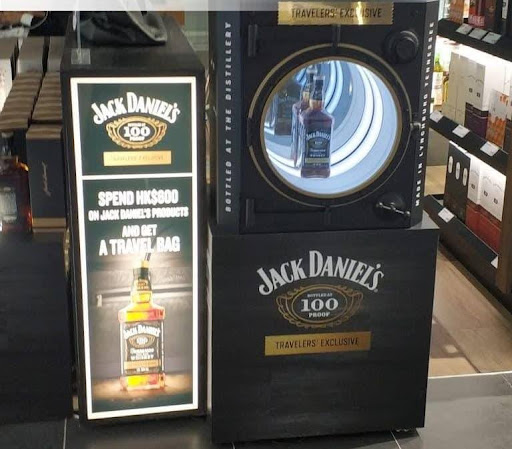Custom Bottle Glorifiers: The Perfect Way to Make Your Brand Stand Out

Custom bottle glorifiers, designed for marketing and promotional purposes, elevate the presentation of bottled products. These displays, commonly found in places like bars, nightclubs, or retail stores, are tailored to reflect a brand’s image. They serve to enhance visibility, attract attention, and make products more appealing.

The Importance of Brand Visibility
In today’s competitive marketplace, brand visibility is paramount. Strengthening brand recognition, credibility, and customer loyalty, high brand visibility ensures products or services occupy prime mental real estate, fostering sales and growth.
Understanding Bottle Glorifiers
Custom bottle glorifiers, as marketing tools, aim to highlight and enhance the presentation of beverages in retail or hospitality settings. Their role is to attract customer attention, increase brand visibility, and potentially drive sales.
Different Types
These displays come in various types, including LED bottle glorifiers that illuminate from beneath, levitating models for a futuristic feel, and ice bucket glorifiers for chilled beverages. Their purpose is to enhance brand visibility in bar and retail settings.
How Custom Bottle Glorifiers Increase Brand Visibility?
Custom bottle glorifiers, as marketing tools, draw customer attention through unique designs, lighting, or strategic positioning. By emphasizing standout features, they successfully stimulate potential purchases.
Importance Of Using Custom Bottle Glorifiers
As the liquor industry continues to keep booming, the competition in the industry grows bigger with time. Hence, marketing and branding your products in the liquor industry becomes tougher. Therefore, you must not settle for less when you are marketing your brand. There is no room for mediocrity in this industry.
The following are some of the major benefits of using custom bottle glorifiers:
1. Better Brand Visibility
One of the best ways to promote your drinks in the market is to use bottle glorifiers. These can help your drink products stand out in the market by making them look premium. Hence, these bottles help in capturing the attention of customers faster. Furthermore, the elegant display of the bottles also gives the brand the authority status.
Once you start using customer brand glorifiers, they will do the talking for the brand themselves. Since these glorifiers have a distinct appeal to themselves, it will help the brand in sending the needed message to customers. Your customers will thus come to know that your products are premium and they constitute high-quality ingredients.
2. Higher Sales
You might already know that if a display is visually appealing to your customers, it will make a lasting impact on their minds. Hence, if you want to increase the revenue of your liquor business and your brand, you must invest in new marketing strategies. One of the major strategies would be to use custom bottle glorifiers.
Furthermore, if you execute your display well enough, it will result in last-minute impulse purchases from consumers. As your customers get familiar with your product displays, they will feel the urge to avail themselves of the product.
3. Your Brand Will Stand Apart
In most cases, once you start using custom bottle glorifiers, you will notice accentuated lights on the labels. Hence, these will make your customers turn their heads towards your products. As a result, it will help your products to stay ahead of their competition in the marketplace, especially when there is a lot of crowd. Therefore, always choose those bottle glorifiers that come with lights.
4. Better Presentation Of The Product
When you are presenting your drinks with bottle glorifiers, you will never go wrong, If you do the presentation part well, it will absolutely increase your sales and, thereby, your revenue. However, you must also realize that using custom bottle glorifiers is just one part of your total marketing process.
Bottle glorifiers have the ability to present your drinks in the most effective and unique manner. Moreover, the attractive presence of these glorifiers will help you catch the attention of not only drink lovers but also others who rarely drink.
Role in Brand Identification
Custom glorifiers play a pivotal role in brand identification by accentuating and drawing attention to products, enhancing product visibility, and contributing to a distinctive brand image.
The Unique Aspect of Custom Bottle Glorifiers
Custom glorifiers significantly contribute to brand promotion by enhancing product visibility and appeal. Tailored to the brand’s identity, they create eye-catching displays, boosting consumer interaction and encouraging purchases.
These bottle glorifiers offer value not only to drink brands but also to the industry. Since they are effective marketing tools, brands do not shy away from making the most of them. Hence, you can use them as perfect promotional products for your drinks as well as your bar.

Illustration of Boost in Brand Visibility
Unique branding elements can significantly boost brand visibility. A distinctive logo or color palette makes a brand easily recognizable, differentiating it from competitors and increasing customer recall.
Benefits of Using Custom Bottle Glorifiers
Increase in Product Awareness
An increase in product awareness is crucial for business success, involving effective marketing strategies to stir customer interest and boost sales.
Enhancement Of Product Appeal
Enhancing product appeal involves improving design, packaging, and features to make a product more attractive and compelling, boosting market competitiveness and consumer satisfaction.
Influence on Purchase Decisions
Consumer purchase decisions are influenced by various factors, including personal preferences, social status, lifestyle, price, product quality, and brand reputation.
Tips for Creating Visually Compelling Glorifiers
Creating visually compelling glorifiers requires careful use of colors, design principles, and text positioning. Emphasizing the product, using consistent branding, and ensuring the display stands out are essential.
Importance of Alignment with Brand Image
Aligning glorifier design with the brand’s image is crucial for maintaining consistency, enhancing visual appeal and recognition, building trust, boosting customer loyalty, and influencing purchasing decisions.
Presentation of Brands Benefiting from Custom Glorifiers
Notable brands like Apple, Coca-Cola, and Chanel have gained immense benefits from custom glorifiers, setting themselves apart in the highly competitive marketplace.
Analysis of Design Approach and Impact on Brand Visibility
An analysis of design approaches provides insights into visual representation strategies. Effective design elevates brand visibility, captures audience interest, and contributes to the brand’s market presence.
Conclusion
In the dynamic and competitive world of marketing, custom bottle glorifiers emerge as an innovative and effective strategy for enhancing brand visibility and distinction. By creating visually striking, unique displays, these glorifiers not only amplify a product’s appeal but also fortify brand identity, making it memorable and recognizable in crowded marketplaces.
The strategic use of custom bottle glorifiers can serve as a pivotal factor in drawing customer attention, influencing purchasing decisions, and ultimately fostering business growth. They represent more than just a marketing tool; they are a creative expression of a brand’s character and a direct path to capturing the imagination and interest of potential customers.
For brands looking to make a substantial impact and leave a lasting impression, investing in custom bottle glorifiers is a step towards achieving these objectives, ensuring that their products not only catch the eyes of potential customers but also etch themselves into the memory of the consumers.
Read More:













